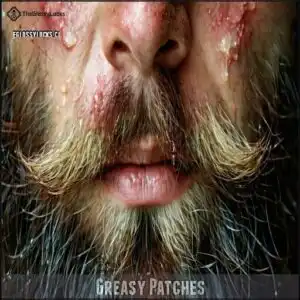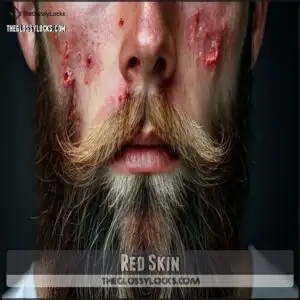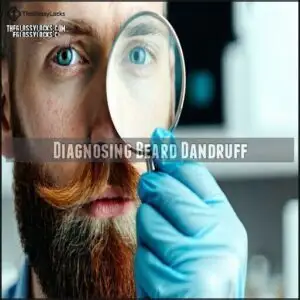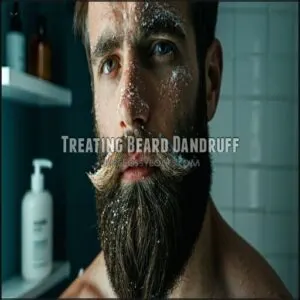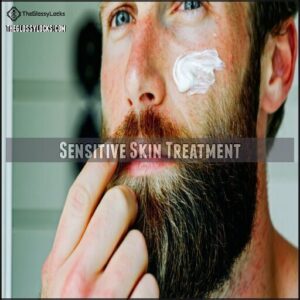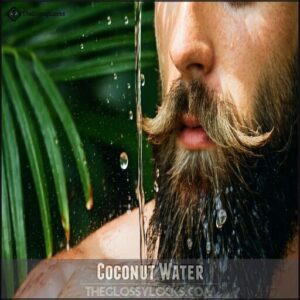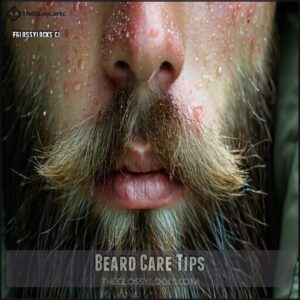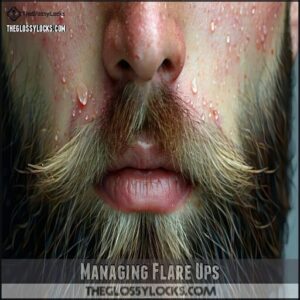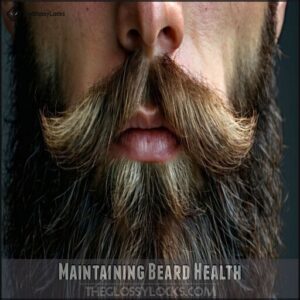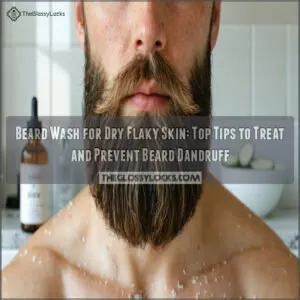This site is supported by our readers. We may earn a commission, at no cost to you, if you purchase through links.
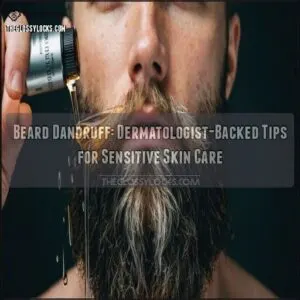 If you’re battling beard dandruff with sensitive skin, you’re not alone.
If you’re battling beard dandruff with sensitive skin, you’re not alone.
Start by using a gentle, fragrance-free cleanser specifically designed for beard care. Look for products with zinc pyrithione or ketoconazole to combat fungal growth without irritating your skin.
Moisturize daily with a lightweight, non-comedogenic beard oil containing ingredients like jojoba or argan oil.
Avoid harsh scrubbing and opt for soft, circular motions when washing.
Keep your beard clean and dry, and consider using a boar bristle brush to distribute natural oils evenly.
Hydration and consistent, gentle care are key to managing beard dandruff and keeping your sensitive skin calm.
Table Of Contents
Key Takeaways
- You’ll need to target the root causes of beard dandruff, including Malassezia yeast and seborrheic dermatitis, by using specialized antifungal treatments like ketoconazole shampoos and gentle cleansers designed for sensitive skin.
- Your beard care routine should focus on maintaining a delicate balance of hydration, using products with natural ingredients like jojoba or argan oil, and avoiding harsh scrubbing that can irritate your skin.
- You’ll want to pay special attention to your skin’s unique needs, incorporating mild exfoliation, consistent moisturizing, and potentially using home remedies like aloe vera gel to soothe inflammation and reduce flaking.
- Your overall beard health depends on a holistic approach, including a balanced diet rich in nutrients, proper sleep, regular trimming, and potentially consulting a dermatologist if symptoms persist or worsen.
What Causes Beard Dandruff
If you’re struggling with beard dandruff, you’re not alone in this frustrating skin condition.
The primary culprits behind those irritating white flakes are seborrheic dermatitis and Malassezia yeast, which thrive in the warm, oily environment of your facial hair and can trigger persistent skin irritation.
Seborrheic Dermatitis
More than half of men experience seborrheic dermatitis, a common skin condition triggering beard dandruff.
Beard dandruff strikes half of men, turning facial hair into a flaky frustration zone.
This inflammatory disorder targets oil-rich areas like your beard, causing intense skin irritation and discomfort.
- Disrupts natural skin microbiome balance
- Causes persistent redness and flaking
- Linked to fungal growth and inflammation
- Requires targeted dermatitis care strategies
Malassezia Yeast
After exploring seborrheic dermatitis, let’s unmask the microscopic culprit behind beard dandruff: Malassezia yeast.
This tiny fungal troublemaker thrives in your beard’s warm, oily environment, triggering skin irritation and flaking.
Tiny but mighty, this beard-dwelling fungus turns your facial hair into a battlefield of irritation and flakes.
Understanding its behavior is key to effective yeast control and sensitive skin care.
| Malassezia Facts | Impact on Beard Health |
|---|---|
| Microscopic Fungus | Triggers Skin Inflammation |
| Feeds on Skin Oils | Causes Beard Dandruff |
| Naturally Occurs | Disrupts Skin Microbiome |
| Overgrowth Leads to Issues | Requires Antifungal Treatment |
Oily Skin Types
After understanding how Malassezia yeast thrives, you’ll see why oily skin becomes a breeding ground for beard dandruff.
Your sebum-rich complexion creates the perfect environment for fungal overgrowth.
Pore minimization and sebum regulation become your secret weapons.
Gentle products with oil control can help restore skin balance, targeting beard dandruff treatment without stripping your skin’s natural defenses.
Seasonal Changes
In the midst of winter’s harsh grip, seasonal changes can wreak havoc on your beard’s health.
Dry air and low humidity create a perfect storm for beard dandruff, triggering skin irritation and flaking.
Your sensitive skin needs extra care during climate shifts.
Maintain beard hydration with targeted seasonal changes to prevent winter flakes and keep your facial hair looking fresh.
Symptoms of Beard Dandruff
If you’ve noticed persistent white flakes, redness, or an uncontrollable itch beneath your beard, you might be experiencing beard dandruff.
These telltale symptoms can signal an underlying skin condition that requires targeted care and understanding.
Skin Flakes
Beard dandruff reveals itself through persistent skin flakes that disrupt your facial hair’s smooth appearance.
Those white or yellowish specks aren’t just annoying—they’re signals of underlying skin issues.
Gentle exfoliation and targeted flake removal can help manage these stubborn patches.
Consistent beard hydration and sensitive skin care are your best defense against this pesky problem, utilizing methods such as gentle exfoliation for stubborn patches, and overall, promoting sensitive skin care.
Greasy Patches
Noticing greasy patches peeking through your beard’s landscape?
These oily skin signals often result from seborrheic dermatitis and Malassezia yeast overgrowth.
Flaky patches emerge when excess beard oil combines with dead skin cells, creating a breeding ground for beard dandruff.
Your skin’s natural oils can transform from protective to problematic, leaving behind telltale greasy residue that screams for attention, often due to Malassezia yeast overgrowth.
Itchy Skin
When those greasy patches start making your beard feel like a scratchy sweater, you’re facing a classic case of skin irritation.
Your beard’s crying out for some TLC with these itch relief strategies:
- Use sensitive skin shampoo
- Apply scalp soothing oil
- Try a soothing beard balm
Persistent itching isn’t just annoying—it’s your skin’s SOS signal for gentle, targeted care, which is essential for maintaining healthy beard hygiene.
Red Skin
When beard dandruff flares up, you’ll spot telltale red skin patches that scream skin irritation.
These inflammation zones often signal underlying seborrheic dermatitis, triggering sensitive skin reactions.
Your redness might stem from yeast overgrowth, harsh product interactions, or environmental stress.
Gentle, targeted beard dandruff treatment can help soothe these angry skin zones and restore your facial comfort, addressing the root cause of skin irritation.
Diagnosing Beard Dandruff
If you’re noticing persistent white flakes and itchiness in your beard, you’ll want to understand the diagnostic process for beard dandruff.
A professional dermatologist can help you distinguish between common skin conditions and provide targeted treatment for your specific symptoms.
Dermatologist Evaluation
If three telltale signs drive you nuts, it’s time to schedule a dermatologist evaluation for your beard troubles.
A professional skin exam can unravel the mystery behind your persistent flaking:
- Detailed medical history review
- Thorough skin testing for underlying conditions
- Expert dermatologist advice on beard dandruff treatment
Understanding the causes of beard dandruff, including fungal overgrowth issues, is essential for effective treatment.
Professional insight transforms your sensitive skin’s landscape, offering liberation from irritating symptoms, and this can lead to a sensitive skin solution with the right beard dandruff treatment.
Similar Symptoms
When traversing the maze of beard irritation, you’ll find that beard dandruff symptoms often mirror other skin conditions.
Understanding these similarities helps pinpoint the right treatment.
| Condition | Key Symptoms |
|---|---|
| Seborrheic Dermatitis | Skin flakes, red rashes |
| Psoriasis | Thick, scaly patches |
| Eczema | Intense itchy skin |
| Fungal Infections | Greasy patches, beard itch |
The conditions listed, including Seborrheic Dermatitis and Eczema, are crucial to understanding the causes of beard dandruff and finding appropriate treatments.
Treating Beard Dandruff
If you’re battling beard dandruff, you’re not alone in this frustrating skin concern.
Targeted treatments like antifungal shampoos and gentle, hydrating products can help you effectively manage those pesky white flakes and restore your beard’s health.
Antifungal Shampoos
After pinpointing beard dandruff through diagnostic steps, you’ll want targeted antifungal shampoos to combat those pesky flakes.
These medicated solutions pack powerful ingredients to restore skin health:
- Target fungal infections with ketoconazole, pyrithione zinc, or selenium sulfide
- Apply to dry skin, massaging thoroughly for 5 minutes
- Use 2-3 times weekly for ideal scalp treatment
Specialized shampoos transform your beard’s appearance, offering relief and renewed confidence. Effective antifungal treatments often involve antifungal shampoo options that are gentle on sensitive skin, providing a solution to restore skin health and improve overall scalp treatment.
Ketoconazole
Ever wondered how to kick beard dandruff to the curb?
Ketoconazole, a powerful antifungal medication, offers targeted relief for sensitive skin.
Available in 1% shampoo formulations, it effectively eliminates fungal infections causing beard dandruff.
Massage the medicated shampoo into your beard for five minutes before rinsing, targeting the root cause and providing thorough skin relief.
Selenium Sulfide
Selenium sulfide emerges as a powerful ally in your beard dandruff battle.
This potent antidandruff shampoo ingredient tackles fungal control with precision, offering skin relief and a sulfide-powered solution.
By disrupting the Malassezia yeast’s growth, selenium sulfide shampoos help cure beard dandruff, restoring your confidence and comfort in one easy wash.
Sensitive Skin Treatment
If you’ve got sensitive skin and beard dandruff, you’ll want to tread carefully with your skincare routine.
Gentle, hydrating cleansers and beard moisturizers can help soothe irritation while targeting the underlying causes of flaking and discomfort. Beard moisturizers can help soothe irritation while targeting the underlying causes of flaking and discomfort.
Mild Cleansers
After battling beard dandruff, finding the right gentle beard wash is key.
Look for sulfate-free, pH-balanced cleansers like Every Man Jack Unscented Beard + Face Wash or Dove Men+Care Deep Clean 3-in-1 Bar.
These fragrance-free beard cleansers remove buildup without stripping natural oils, keeping your skin calm and your beard healthy during daily use.
Many find that fragrance-free cleansers help minimize irritation.
Hydrating Ingredients
After choosing mild cleansers, you’ll want hydrating ingredients that build your skin’s defense.
Natural humectants like glycerin and hyaluronic acid draw moisture deep into beard-covered areas, reinforcing lipid barriers.
Ceramides restore skin’s protective shield, combating dry skin and beard dandruff while keeping your facial hair’s ecosystem balanced and healthy.
Beard Moisturizer
Nourishing your beard’s skin starts with selecting the right beard moisturizer.
Target hydration levels carefully, choosing products with soothing ingredients like argan or jojoba oil that won’t clog pores.
Apply sparingly to prevent excess oil buildup, focusing on massaging into the skin beneath your facial hair.
For sensitive skin, opt for hypoallergenic beard care products that maintain natural oil balance.
Many users find beard hydration products particularly helpful.
Home Remedies
When battling beard dandruff, you’ll want to explore gentle, natural home remedies that can soothe your sensitive skin and reduce irritation.
These simple solutions like aloe vera gel, apple cider vinegar, and coconut water offer effective, dermatologist-approved strategies to help you manage beard flakes and calm inflammation.
Aloe Vera Gel
If soothing sensitive skin sounds like your beard care goal, aloe vera gel might be your secret weapon.
This natural powerhouse offers relief from beard dandruff with its impressive healing properties.
Here’s how to harness its potential:
- Select pure, dermatologist-approved aloe vera gel
- Perform a patch test before full application
- Apply directly to skin under your beard
- Let it air dry completely
- Use consistently for best results
Your skin will thank you.
Apple Cider Vinegar
After soothing your beard with aloe vera, apple cider vinegar offers another natural weapon against beard dandruff.
Its antimicrobial properties can help balance skin pH and combat fungal growth.
Dilute ACV carefully to prevent irritation – a little goes a long way in your beard care arsenal.
| ACV Benefit | Beard Care Impact |
|---|---|
| pH Balance | Reduces Fungal Growth |
| Antimicrobial | Controls Skin Irritation |
| Natural Remedy | Minimizes Dandruff |
| Gentle Cleansing | Prevents Skin Buildup |
| Cost-Effective | Supports Skin Health |
Coconut Water
Splash some coconut water into your beard care routine to tackle dandruff naturally.
Its hydration properties help soothe sensitive skin and combat itchy beard conditions.
Rich in nutrients and electrolytes, coconut water can be applied directly or mixed into beard products to reduce inflammation and provide gentle, natural relief from persistent beard dandruff.
Preventing Beard Dandruff
Preventing beard dandruff starts with understanding your skin’s unique needs and developing a targeted care routine.
By implementing consistent hygiene practices and using the right products, you’ll effectively manage and reduce those pesky white flakes that can make your beard look less than pristine.
Regular Washing
By springtime, when beard dandruff peaks, master your washing routine.
Use a gentle beard wash 1-2 times weekly, targeting skin beneath facial hair.
Rinse thoroughly with lukewarm water, ensuring no product residue remains.
Avoid over-washing, which strips natural oils and triggers skin sensitivity.
Pat your beard dry gently, preserving its natural moisture and preventing irritation.
Exfoliation
The science of beard exfoliation reveals a transformative approach to managing skin beneath your facial hair.
Gently remove dead skin cells once or twice weekly using a soft-bristled beard exfoliant to prevent dandruff buildup.
Choose sensitive exfoliation methods that won’t irritate your skin, targeting flakes without causing inflammation or discomfort.
Your beard will thank you.
Beard Oil
Beard oil isn’t just a luxury—it’s your secret weapon against beard dandruff.
By hydrating both facial hair and underlying skin, these carrier oil blends combat dryness and reduce beard itch.
Choose oils like jojoba or argan that mimic natural skin sebum, preventing flakiness and soothing irritation.
Apply sparingly after washing, massaging into beard and skin for maximum effectiveness.
Beard Care Tips
If you’re battling beard dandruff, you’re not alone in this frustrating skin challenge.
Effective beard care for sensitive skin requires understanding your unique skin microbiome and adopting targeted, gentle cleansing techniques that balance hydration and minimize irritation.
Avoid Petroleum Jelly
When managing beard dandruff, steer clear of petroleum jelly.
This sticky substance can wreak havoc on your sensitive skin, clogging pores and trapping moisture that fuels fungal growth.
Instead, opt for natural occlusives like jojoba oil or shea butter, which moisturize without suffocating your skin.
Your beard deserves breathable, skin-friendly alternatives that support healthy facial hair.
Gentle Shampoos
When petroleum jelly falls short, gentle beard shampoos become your skin’s new best friend.
Navigate beard care with smart choices that soothe and protect.
One should also consider how natural oils are preserved when selecting a shampoo.
Consider these game-changing beard wash strategies:
- Opt for sulfate-free options
- Prioritize natural ingredients
- Check pH balance compatibility
- Select fragrance-free formulations
- Use mild anti-dandruff beard washes
Your skin deserves tender, scientific care that stops irritation in its tracks.
Boar Bristle Brush
If you’re battling beard dandruff, a boar bristle brush could be your secret weapon.
These brushes gently distribute natural oils, reducing beard itch and preventing flaky buildup.
Bristle quality matters—look for dense, soft bristles that exfoliate without irritating sensitive skin. Regular brushing helps spread beard oil evenly, keeping your facial hair healthy and dandruff-free.
You can find a wide selection online.
Managing Flare Ups
When beard dandruff flares up, you’ll want to tackle the problem head-on with targeted treatments that address the underlying causes.
Understanding how to manage these unexpected skin irritations can help you maintain a healthy, comfortable beard and prevent future outbreaks.
Over-the-Counter Treatments
After mastering beard care techniques, you’ll want to tackle those pesky flakes with OTC efficacy.
Anti-dandruff shampoos like ketoconazole and selenium sulfide are your first line of defense.
Look for products with targeted ingredients that kill fungus and control yeast growth.
Consistent application is key – massage thoroughly, let sit for five minutes, and rinse completely to manage beard dandruff effectively.
Prescription Options
When beard dandruff becomes a persistent battle, it’s time to explore prescription options that go beyond over-the-counter solutions.
Your dermatologist might recommend these critical interventions:
- Topical steroids for rapid inflammation reduction
- Oral antifungals to combat stubborn seborrheic dermatitis
- Calcineurin inhibitors for sensitive skin
- Cortisone solutions for targeted relief
- Advanced prescription treatments for severe cases
A professional consultation guarantees personalized, effective management.
Maintaining Beard Health
Your beard’s health isn’t just about looking good—it’s a reflection of your skin’s well-being.
By understanding the right care techniques, you’ll tackle beard dandruff effectively and keep your facial hair looking clean, comfortable, and confident.
Balanced Diet
Every bite you take can impact your beard’s health through nutrient absorption and gut balance. Your diet plays a key role in combating beard dandruff by supporting skin health and reducing inflammation.
| Nutrient | Beard Benefits |
|---|---|
| Omega-3s | Reduces inflammation |
| Zinc | Supports skin healing |
| Probiotics | Balances microbiome |
| Hydrating Foods | Prevents skin dryness |
Choosing whole, nutrient-dense foods can be your secret weapon against stubborn beard flakes.
Adequate Sleep
A nutrient-rich diet supports your body’s repair mechanisms, but quality sleep truly transforms skin health.
When you catch enough Z’s, you’re not just resting—you’re giving your skin a nightly tune-up.
Improved sleep duration boosts immune function, reduces stress, and helps combat beard dandruff by promoting cellular regeneration and maintaining peak skin hydration.
Regular Trimming
After catching solid shut-eye, you’ll want to keep your beard in top shape with strategic trimming.
Regular maintenance isn’t just about looks—it’s a game-changer for beard health.
Here’s how to trim like a pro:
- Invest in quality beard scissors
- Remove split ends carefully
- Maintain symmetrical growth patterns
- Check for uneven patches
- Use gentle, precise movements
Trimming prevents dandruff build-up and keeps your facial hair looking sharp.
To maintain your beard, consider using adjustable length guards for consistent results.
Frequently Asked Questions (FAQs)
Can sensitive skin worsen beard dandruff symptoms?
When the skin’s an angry beast, trouble’s sure to lurk."
Sensitive skin can indeed amplify beard dandruff symptoms, making your facial hair prone to increased irritation, inflammation, and more intense flaking due to heightened skin reactivity.
How often should I see a dermatologist?
If your beard dandruff persists or worsens despite home treatments, you’ll want to see a dermatologist annually or immediately if symptoms considerably impact your comfort, confidence, or daily life.
Are natural remedies safe for sensitive skin?
When Mother Nature whispers healing secrets, natural remedies can soothe sensitive skin.
Gentle ingredients like aloe vera and chamomile offer relief, but you’ll want to patch test first and consult a dermatologist for personalized guidance.
What triggers beard dandruff in sensitive skin?
You’ll likely see beard dandruff pop up when Malassezia yeast overgrows, triggered by stress, hormonal changes, oily products, and environmental shifts that disrupt your skin’s delicate microbiome balance.
Can diet impact beard dandruff severity?
Your diet can influence beard dandruff.
Nutrient-rich foods combat inflammation and support skin health.
Zinc, omega-3s, and probiotics help regulate skin microbiome, potentially reducing Malassezia yeast overgrowth and minimizing flaking.
Conclusion
Ready to conquer beard dandruff with sensitive skin? Remember, managing this condition isn’t just about appearance—it’s about skin health.
Your personalized beard dandruff treatment strategy involves gentle cleansing, targeted antifungal solutions, and consistent moisturizing.
By understanding your skin’s unique needs and using dermatologist-recommended techniques, you’ll effectively combat flakes, reduce irritation, and maintain a healthy, comfortable beard.
Stay patient, follow expert advice, and you’ll see remarkable improvements in your beard and skin care routine.



